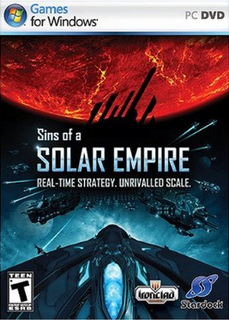A sleeper ship is a hypothetical type of crewed spacecraft in which most or all of the crew spend the journey in some form of hibernation or suspended animation. The only known technology that allows long-term suspended animation of humans is the freezing of early-stage human embryos through embryo cryopreservation, which is behind the concept of embryo space colonization.

Asheron's Call 2: Fallen Kings was a fantasy massively multiplayer online role-playing game (MMORPG) for Microsoft Windows PCs which was released on November 22, 2002 and shut down on December 30, 2005. In 2012, it was relaunched as a beta for active Asheron's Call subscribers. It is a sequel to 1999's Asheron's Call, although content, graphics and gameplay dynamics differed greatly from its predecessor.

Starflight 2: Trade Routes of the Cloud Nebula is a 1989 science fiction video game developed by Binary Systems and published by Electronic Arts as the sequel to the successful Starflight. It features a combination of space exploration, role-playing and strategy within a futuristic setting. The player commands a spaceship capable of traveling to the game world's 150 solar systems, communicating with or attacking other spaceships, and landing on planetary surfaces which may be explored with a crewed rover for plot clues, minerals and alien lifeforms. Game mechanics and the overall look and feel closely resemble the earlier Starflight game, but many new features are introduced including an interstellar trade-based economy, new sentient alien races, and new spacecraft accessories and artifacts. The player is tasked with discovering the ultimate source of the advanced spacecraft technology and unlimited fuel supply which provide a military advantage to the Spemin, a hostile alien race threatening to annihilate or enslave humanity. A major part of the game consists of earning enough money to pay for spaceship upgrades and crew training by engaging in interstellar trade and barter with various alien cultures at their planetary trading posts.

Galactic Civilizations II: Dread Lords is a 4X turn-based strategy by Stardock for Microsoft Windows. It is the sequel to the original Galactic Civilizations, and was released at retail and on Stardock's online subscription service, TotalGaming.net, on February 21, 2006. An expansion, Dark Avatar, was released in February 2007. A second expansion, Twilight of the Arnor, was released in April 2008.

Richard Garriott's Tabula Rasa is a defunct MMORPG developed by Destination Games and published by NCsoft, designed in part by some including Richard Garriott. The game is a role-playing video game that blends certain shooter aspects into the combat system. It was officially released to retail on November 2, 2007, with customers that pre-ordered the game allowed access to the live servers from October 30, 2007. The development team released updates, called "Deployments," nearly every month following launch. The game required a monthly subscription.

Sins of a Solar Empire is a 2008 science fiction real-time strategy video game developed by Ironclad Games and published by Stardock Entertainment for Microsoft Windows operating systems. It is a real-time strategy (RTS) game that incorporates some elements from 4X games; its makers describe it as "RT4X". Players are given control of a spacefaring empire in the distant future, and are tasked with conquering star systems using military, economic and diplomatic means.

SpellForce 2: Shadow Wars is a 2006 real-time strategy and role-playing video game, developed by Phenomic and published by JoWooD Productions. The second instalment in the SpellForce series, the game takes place several years after the events of 2003's SpellForce: The Order of Dawn, with players assuming the role of an immortal warrior who seeks aid to protect his homeland from invaders, only to be drawn on a quest to defeat a powerful alchemist responsible for creating the immortality of the warrior and his people. The game combines elements of role-playing such as taking on quests, equipping characters and improving them when levelling up, alongside real-time strategy elements focused on gathering resources to construct bases and units.
Planetarion is a browser-based massively multiplayer online game. Created by Fifth Season AS in early 2000, then bought by Jolt in 2003, and then purchased by Renegade Games in 2009; it is now currently owned by Jagex. The game places players in control of a planet, with the ability to mine its asteroids for resources, enabling them to construct a fleet of spaceships to attack other players' planets. Although its popularity has declined with the emergence of other similar games and the introduction of a pay-to-play model, which has since been changed to a freemium format, the game is currently still active, and as such is one of the oldest running internet games of its genre.

Warhammer 40,000: Dawn of War – Dark Crusade is the second expansion to the Real-time strategy video game Warhammer 40,000: Dawn of War developed by Relic Entertainment and published by THQ. Based on Games Workshop's tabletop wargame, Warhammer 40,000, Dark Crusade was released on October 9, 2006. The expansion features two new races, the Tau Empire and the Necrons. Including the Imperial Guard from Dawn of War's first expansion pack Winter Assault, a total of seven playable races in this expansion.
X is a science fiction space trading and combat simulator series created by German developer Egosoft. The series is set in the X-Universe where several races populate a number of worlds connected by jumpgates. The games feature free roaming gameplay with trading, combat, empire building, and missions; leading to the series' phrase: "Trade, Fight, Build, Think". The series, which was launched in 1999 on the Windows platform, consists of five base games: X: Beyond the Frontier, X2: The Threat, X3: Reunion, X Rebirth, and X4: Foundations. X Rebirth introduced a new rendering engine as well as a new plot, one which X4: Foundations now extends the storyline beyond ten years after the events in X Rebirth.
Infinity is a postponed massively multiplayer online space simulation video game originally intended to be the first game built on the I-Novae engine by I-Novae Studios. While the I-Novae engine has been in development since 2004, development of Infinity never started.

Tales from Space: About a Blob is a side-scrolling puzzle-platform game about a race of alien Blobs developed and published by DrinkBox Studios for the PlayStation 3 video game console. The game has a retro-inspired monster-movie art style and local co-op gameplay.

Super Stardust Delta is a twin-stick multidirectional shooter video game for the PlayStation Vita handheld console. It is part of the Stardust series of games developed by the Finnish company Housemarque.

Marvel Avengers: Battle for Earth is a video game developed by Ubisoft Quebec and published by Ubisoft for the Xbox 360 and the Wii U. The game is heavily based on the "Secret Invasion" storyline in Marvel comic books. The game was announced after the cancellation of the original The Avengers game based on the 2012 film of the same name, being developed by THQ. Battle for Earth was released in North America on October 30, 2012 for the Xbox 360, followed by the Wii U version on December 4. The game was also the only Marvel video game to be published by Ubisoft.

Warhammer 40,000: Eternal Crusade was a science fiction online third-person shooter video game based on the Warhammer 40,000 universe. The game was released on September 23, 2016 for Microsoft Windows. As of January 2016 it was planned to release the game for PlayStation 4 and Xbox One on a later date.

Planets Under Attack is a strategy video game inspired by Galcon and developed by Targem Games.

Warhammer 40,000: Storm of Vengeance is a real-time strategy video game developed and published by Eutechnyx. It was released for Microsoft Windows, Android and iOS. Warhammer 40,000: Storm of Vengeance was set in the Warhammer 40,000 universe, it follows the Dark Angels, commanded by Grand Master Belial, and the Bad Moons, commanded by Ork Warlord Ghazghkull Thraka on the planet Piscina IV. Warhammer 40,000: Storm of Vengeance was released on 3 April 2014 (Steam), 23 April 2014 and 1 May 2014 (iOS).

Marvel Contest of Champions is a 2014 fighting video game developed and published by Kabam. It was released on December 10, 2014, for iOS and Android. The fighting game is primarily set in the Marvel Universe. The game is strongly based on the events of the limited comic book series Contest of Champions. An arcade version was released in 2019, developed by Raw Thrills and is exclusive to Dave & Buster's locations.

Endless Space 2 is a turn-based strategy, science fiction 4X game developed by Amplitude Studios. It is the sequel to Endless Space, which was released in 2012. The game had been made available through Steam's early access program since October 2016. It was released on May 18, 2017.

Doki Doki Literature Club! (DDLC) is a 2017 freeware visual novel developed by American independent game studio Team Salvato for Microsoft Windows, macOS, and Linux. The game was initially distributed through itch.io, and later became available on Steam. The story is told from the perspective of a high school student who reluctantly joins the school's literature club on the insistence of his best friend from his childhood, and is given the option to woo three of its four female members. Doki Doki Literature Club! features a non-traditional plot structure with multiple endings and unlockable cutscenes with each of the main characters. Although the game initially appears to be a lighthearted dating simulator, it is in fact a psychological horror game that extensively breaks the fourth wall.
















